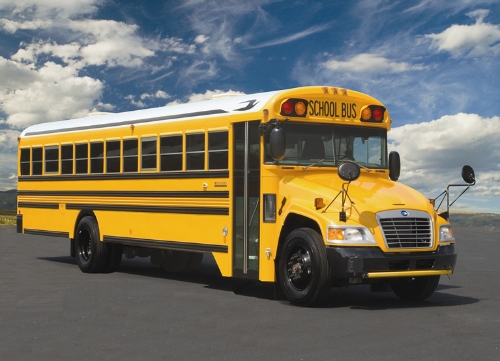High Schools in the United States
In most jurisdictions, secondary education in the United States refers to the last six or eight years of statutory formal education. Secondary education is generally split between junior high school or middle school, usually beginning with sixth or seventh grade (at or around age 11 or 12), and high school, beginning with ninth grade (at or around age 14) and progressing to 12th grade (ending at or around age 18). Junior high school refers to grades seven through nine.
There is a wide variance in curriculum for students in the United States. Since the turn of the 20th century, many high schools in the United States have offered a choice of vocational or college prep curriculum. Schools that offer vocational programs include a very high level of technical specialization, e.g., auto mechanics or carpentry, with a half-day instruction/approved work program in senior year as the purpose of the program is to prepare students for gainful employment without a college degree. The level of specialization allowed varies depending on both the state and district the school is located in. The Association for Career and Technical Education is the largest U.S. association dedicated to promoting this type of education.
A class period is the time allotted for one class session. The classes a student signs up for are arranged in a certain order to fit his or her individual schedule and generally do not change for the remainder of the school year (with the exception of semester courses). A period may vary in time, but is usually 30–90 minutes long. Most schools have 7-8 class short (30–45-minute) periods on their daily schedule, although some have an alternating block of 3–4 class periods each day (typically 90 minutes). Many offer the option of including a study hall in a student's schedule.
There is wide variance in the curriculum required each year but many American high schools require that courses in the "core" areas of English, science, social studies, and mathematics be taken by the students every year although other schools merely set the required number of credits and allow the student a great deal of choice as to when the courses will be taken after 10th grade.
 The majority of high schools require four English credits to graduate. Typically, all four levels of English classes include both standard and honors options. English III and English IV may feature AP opportunities to earn college credits, as well.
The majority of high schools require four English credits to graduate. Typically, all four levels of English classes include both standard and honors options. English III and English IV may feature AP opportunities to earn college credits, as well.
Generally, three science courses are required. Biology, chemistry, and physics are usually offered. Courses such as physical and life science serve as introductory alternatives to those classes. Other science studies include geology, anatomy, astronomy, health science, environmental science, and forensic science.
Education in the United States is provided by both public and private schools. Public education is universally available, with control and funding coming from the state, local, and federal government. Public school curricula, funding, teaching, employment, and other policies are set through locally elected school boards, who have jurisdiction over individual school districts. State governments set educational standards and mandate standardized tests for public school systems.
Private schools are generally free to determine their own curriculum and staffing policies, with voluntary accreditation available through independent regional accreditation authorities. 88% of school-age children attend public schools, 9% attend private schools, and nearly 3% are homeschooled.
Private schools in the United States include parochial schools (affiliated with religious denominations), non-profit independent schools, and for-profit private schools. Private schools charge varying rates depending on geographic location, the school's expenses, and the availability of funding from sources, other than tuition. For example, some churches partially subsidize private schools for their members.
Private schools have various missions: some cater to college-bound students seeking a competitive edge in the college admissions process; others are for gifted students, students with learning disabilities or other special needs, or students with specific religious affiliations. Some cater to families seeking a small school, with a nurturing, supportive environment. Unlike public school systems, private schools have no legal obligation to accept any interested student. Admission to some private schools is often highly selective. Private schools also have the ability to permanently expel persistently unruly students, a disciplinary option not legally available to public school systems.
Private schools offer the advantages of smaller classes, under twenty students in a typical elementary classroom, for example; a higher teacher/student ratio across the school day, greater individualized attention and in the more competitive schools, expert college placement services. Unless specifically designed to do so, private schools usually cannot offer the services required by students with serious or multiple learning, emotional, or behavioral issues. Although reputed to pay lower salaries than public school systems, private schools often attract teachers by offering high-quality professional development opportunities, including tuition grants for advanced degrees. According to elite private schools themselves, this investment in faculty development helps maintain the high quality program that they offer.
From Wikipedia, the free encyclopedia
Why would you send your daughter to an all Girls’ School?
- > John Bapst high School, Bangor, Maine
- > US State of California
- > Besant Hill School, Ojai, California
- > Lake Tahoe Preparatory School, Lake Tahoe, California
- > US State of Colorado
- > US State of Connecticut
- > Marianapolis Preparatory School, Thompson, Connecticut
- > Woodstock Academy, Woodstock, Connecticut
- > US state of Florida
- > Admiral Farragut Academy, St Petersburg, Florida
- > US State of Georgia
- > Riverside Military Academy, Gainesville, Georgia
- > US State of Hawaii
- > Hawaii Preparatory Academy, Kamuela, Hawaii
- > Hawaii Preparatory Academy, Equestrian Program
- > US State of Illinois
- > US State of Maine
- > Lincoln Academy, Newcastle, Maine
- > Thornton Academy, Saco, Maine
- > Washington Academy, East Machias, Maine
- > US State of Maryland
- > Calverton School, Huntingtown, Maryland
- > US State of Massachusetts
- > The Newman School, Boston, Massachusetts
- > US State of Missouri
- > Chaminade College Preparatory School, St Louis, Missouri
- > US State of New York
- > North Country School (Lake Placid, New York)
- > The Storm King School, Cornwall-on-Hudson, New York
- > Ross School, East Hampton, New York State
- > Windsor School, New York, New York State
- > US State of Pennsylvania
- > Perkiomen School, Pennsburg, Pennsylvania
- > Solebury School, New Hope, Pennsylvania
- > US State of South Carolina
- > US State of Texas
- > US State of Tennessee
- > McCallie School, Chattanooga, Tennessee
- > US State of Utah
- > Layton Christian Academy, Layton, Utah
- > Wasatch Academy, Mt. Pleasant, Utah
- > Wasatch Academy (Mt Pleasant, Utah) Equestrian and Rodeo programme
- > US State of Vermont
- > North Cedar Academy, Ladysmith, Wisconsin
2022 Summer at Thornton Academy, Maine USA Saco, Maine, USA

Discover new classes and make friends for life at the Summer at Thornton Academy program. Held on Thornton Academy's beautiful campus.
Students live in Thornton Academy’s modern dormitories in double placement. The dormitories have bathrooms, laundry, kitchen, and lounges for studying and socializing. Staying in the dorm is one of the most important and fun parts of the program. Hang out with your new friends and practice your conversational English.
Duration: 2-4 weeks
Price: US$ 3,000 for 2 weeks
2022 Summer at Thornton Academy, Maine USA
Elite Snowsport Training at Vail Mountain School, Colorado Vail, Colorado

High School plus Elite Snow Sport
Vail Mountain School is a proud academic partner of Ski and Snowboard Club Vail (SSCV), offering Alpine, Freeski, Freestyle, Nordic and Snowboard. Our relationship means that a student at VMS can train at an elite level and receive a rigorous college-preparatory education without compromising either. As members of the Vail Mountain School community, it also means that these athletes will have social, enrichment, and athletic opportunities beyond the mountain.
Duration: 1 academic year
Level: certificate of attendance Price: 28,000 US$
Elite Snowsport Training at Vail Mountain School, Colorado

High Schools in the United States per State
The following high schools in the United States are on offer through StudyUnitedStates EU. If you need more information, or would like to apply with any of these schools, please contact StudyUnitedStates EU <- click for e-mail
California
Besant Hill School of Happy Valley, Ojai, California
Squaw Valley Academy, Lake Tahoe, California
Connecticut
Marianapolis Preparatory School, Thompson, Connecticut
Woodstock Academy, Woodstock, Connecticut
Florida
Admiral Farragut Academy, St. Petersburg, Florida
Georgia
Riverside Military Academy, Gainesville, Georgia
Hawaii
Hawaii Preparatory Academy, Kamuela, Hawaii
Hawaii Preparatory Academy, Equestrian Program
Maryland
Calverton School, Huntingtown, Maryland
Maine
John Bapst, Bangor, Maine
Lincoln Academy, Newcastle, Maine
Thornton Academy, Saco, Maine
Washington Academy, East Machias, Maine
Massachusetts
The Newman School, Boston, Massachusetts
Michigan
Missouri
Chaminade College Preparatory School, St. Louis, Missouri
New York
North Country School, Lake Placid, New York
The Storm King School, Cornwall-on-Hudson, New York
Ross School, East Hampton, New York State
Pennsylvania
Perkiomen School, Pennsburg, pennsylvania
Solebury School, New Hope, Pennsylvania
South Carolina
Tennessee
McCallie School (Boys), Chattaooga, Tennessee
Utah
Layton Christian Academy, Layton, Utah
Wasatch Academy, Mt. Pleasant, Utah
Vermont
Wisconsin
North Cedar Academy, Ladysmith, Wisconsin
Wyoming


 The majority of high schools require four English credits to graduate. Typically, all four levels of English classes include both standard and honors options. English III and English IV may feature AP opportunities to earn college credits, as well.
The majority of high schools require four English credits to graduate. Typically, all four levels of English classes include both standard and honors options. English III and English IV may feature AP opportunities to earn college credits, as well.


